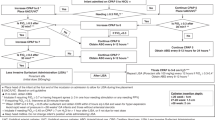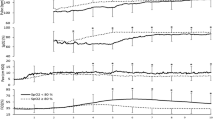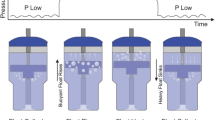Abstract
Objective:
To compare the effectiveness of 100% oxygen therapy vs oxygen treatment with targeted pulse oximetry in the management of symptomatic small to moderate spontaneous pneumothorax (SP). In total, 100% oxygen treatment for SP has been a common practice in neonatology, albeit there is little evidence to validate its efficacy.
Study Design:
A retrospective chart review of 83 neonatal records with the diagnosis of pneumothorax was conducted. Infants <35 weeks gestation, those with large pneumothoraces requiring chest tube drainage and/or ventilatory support were excluded. Data gathered included demographics, vital signs, treatment information and clinical indicators of resolution of symptoms.
Result:
In total, 45 neonates with SP were included in the study. Groups were similar for gestational age, birth weight, Apgar scores, gravidity, parity, gender, race, pneumothorax size and location. Patients in the 100% oxygen therapy group received a significantly longer oxygen treatment (21.3 vs 8 h, P<0.001), required longer intravenous fluid treatment (48.6±29.9 vs 31.3± 18.8 h, P=0.03) and were delayed in reaching full feeds (44.1±25.7 vs 29.5±18.8 h, P=0.03) compared with the oxygen-targeted treatment group. Time to first oral feeding, time to resolution of tachypnea and length of stay were similar in both groups.
Conclusion:
There are no clinically significant advantages to using 100% oxygen in the treatment of symptomatic small to moderate SP. In fact, it may result in longer exposure to unnecessary oxygen treatment and toxicity. Oxygen should be reserved for those who are hypoxic and adjusted to comply with accepted saturation levels in neonates.
This is a preview of subscription content, access via your institution
Access options
Subscribe to this journal
Receive 12 print issues and online access
$259.00 per year
only $21.58 per issue
Buy this article
- Purchase on Springer Link
- Instant access to full article PDF
Prices may be subject to local taxes which are calculated during checkout

Similar content being viewed by others
References
Davis C, Stevens G . Value of routine radiographic examination of the newborn, based on a study of 702 consecutive babies. Am J Obstet Gynecol 1930; 20: 73.
Chernick V, Avery ME . Spontaneous alveolar rupture at birth. Pediatrics 1963; 32: 816–824.
Trevisanuto D, Doglioni N, Ferrarese P, Vedovato S, Cosmi E, Zanardo V . Neonatal pneumothorax: comparison between neonatal transfers and inborn infants. J Perinat Med 2005; 33: 449–454.
Steele RW, Metz JR, Bass JW, DuBois JJ . Pneumothorax and pneumomediastinum in the newborn. Radiology 1971; 98: 629–632.
Northfield TC . Oxygen therapy for spontaneous pneumothorax. Br Med J 1971; 4: 86–88.
Maltepe E, Saugstad OD . Oxygen in health and disease: regulation of oxygen homeostasis–clinical implications. Pediatr Res 2009; 65: 261–268.
Saugstad OD . Oxygen toxicity in the neonatal period. Acta Paediatr Scand 1990; 79: 881–892.
Saugstad OD, Sejersted Y, Solberg R, Wollen EJ, Bjørås M . Oxygenation of the newborn: a molecular approach. Neonatology 2012; 101: 315–325.
Saugstad OD . Resuscitation of newborn infants: from oxygen to room air. Lancet 2010; 376: 1970–1971.
Shoji H, Koletzko B . Oxidative stress and antioxidant protection in the perinatal period. Curr Opin Clin Nutr Metab Care 2007; 10: 324–328.
Richardson DK, Corcoran JD, Escobar GJ, Lee SK . SNAP-II and SNAPPE-II: Simplified newborn illness severity and mortality risk scores. J Pediatr 2001; 138: 92–100.
Stevens TP, Dylag A, Panthagani I, Pryhuber G, Halterman J . Effect of cumulative oxygen exposure on respiratory symptoms during infancy among VLBW infants without bronchopulmonary dysplasia. Pediatr Pulmonol 2010; 45: 371–379.
Ashmore PG . Spontaneous pneumothorax in the newborn. Can Med Assoc J 1965; 92: 309–311.
Baumann MH, Strange C, Heffner JE, Light R, Kirby TJ, Klein J et al. AACP Pneumothorax Consensus Group Management of spontaneous pneumothorax: an American College of Chest Physicians Delphi consensus statement. Chest 2001; 119: 590–602.
Henry M, Arnold T, Harvey J Pleural Diseases Group. Standards of Care Committee, British Thoracic Society. BTS guidelines for the management of spontaneous pneumothorax. Thorax 2003; 58: 39–52.
Al Tawil K, Abu-Ekteish FM, Tamimi O, Al Hathal MM, Al Hathlol K, Abu Laimun B . Symptomatic spontaneous pneumothorax in term newborn infants. Pediatr Pulmonol 2004; 37: 443–446.
Yu VY, Liew SW, Robertson NR . Pneumothorax in the newborn. Changing pattern. Arch Dis Child. 1975; 50: 449–453.
Butler DA, Orlowski JP . Nitrogen washout therapy for pneumothorax. Cleve Clin Q 1983; 50: 311–315.
England GJ, Hill RC, Timberlake GA, Harrah JD, Hill JF, Shahan YA et al. Resolution of experimental pneumothorax in rabbits by graded oxygen therapy. J Trama 1998; 45: 333–334.
Hill RC, DeCarlo DP Jr, Hill JF, Beamer KC, Hill ML, Timberlake GA . Resolution of experimental pneumothorax in rabbits by oxygen therapy. Ann Thorac Surg 1995; 59: 825–827.
Zierold D, Lee SL, Subramanian S, DuBois JJ . Supplemental oxygen improves resolution of injury-induced pneumothorax. J Pediatr Surg 2000; 35: 998–1001.
Vento M, Sastre J, Asensi MA, Viña J . Room-air resuscitation causes less damage to heart and kidney than 100% oxygen. Am J Respir Crit Care Med 2005; 172: 1393–1398.
Jackson RM . Pulmonary oxygen toxicity. Chest 1985; 88: 900–905.
Vento M, Escobar J, Cernada M, Escrig R, Aguar M . The use and misuse of oxygen during the neonatal period. Clin Perinatol 2012; 39: 165–176.
Author information
Authors and Affiliations
Corresponding author
Ethics declarations
Competing interests
The authors declare no conflict of interest.
Rights and permissions
About this article
Cite this article
Clark, S., Saker, F., Schneeberger, M. et al. Administration of 100% oxygen does not hasten resolution of symptomatic spontaneous pneumothorax in neonates. J Perinatol 34, 528–531 (2014). https://doi.org/10.1038/jp.2014.55
Received:
Revised:
Accepted:
Published:
Issue Date:
DOI: https://doi.org/10.1038/jp.2014.55



